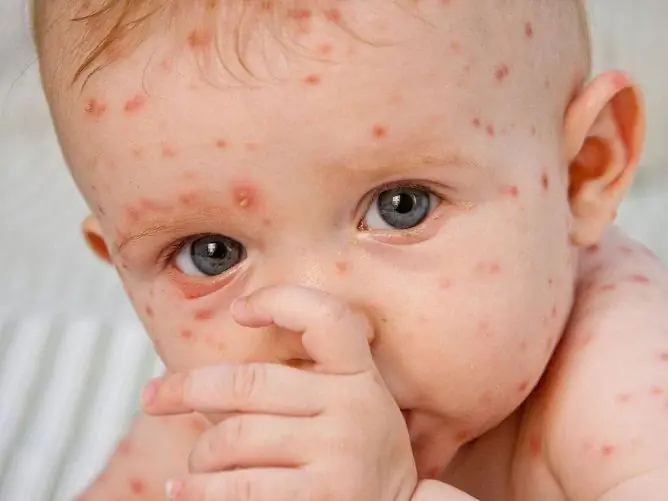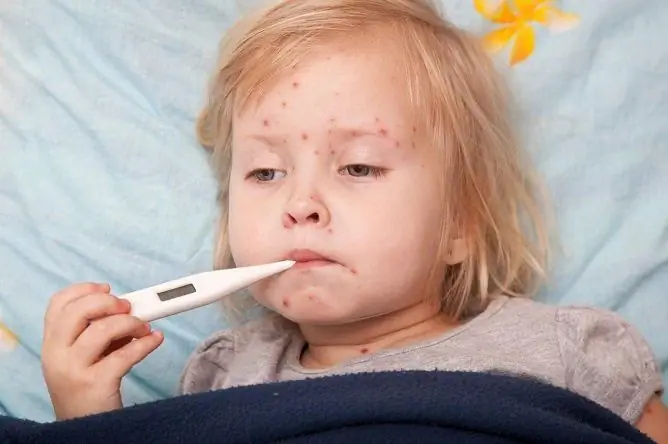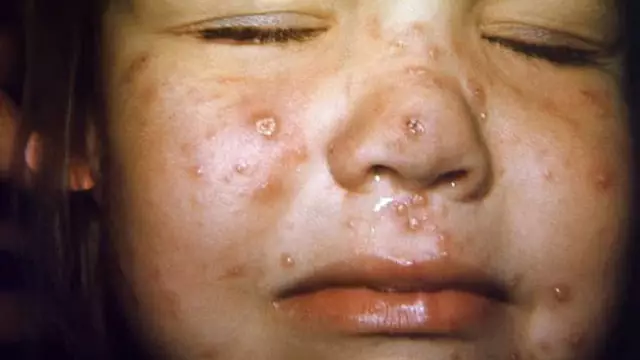- Author Rachel Wainwright [email protected].
- Public 2024-01-15 19:51.
- Last modified 2025-11-02 20:14.
Is it possible to get chickenpox in adulthood for the second time: causes of virus reactivation, treatment
The content of the article:
-
Brief characteristics of the varicella-zoster virus
Pathogen transmission mechanism
- Pathogenesis and symptoms of chickenpox
-
Chickenpox immunity
Reasons and differences in the course of repeated chickenpox
-
Differential diagnosis of chickenpox
Differences in complications
- Treatment of Recurrent Varicella Zoster Virus Disease in Adults
- Video
Is it possible to get chickenpox in adulthood for the second time - a frequent question of parents of children who have had chickenpox at the doctor's appointment.

Adults are often interested in whether it is possible to get chickenpox again
In medicine, isolated cases are described when a person could have had chickenpox twice (a case of seven chickenpox in 4 years is described). But upon closer examination, these were the reactivation of a virus already existing in the body.
Brief characteristics of the varicella-zoster virus
The causative agent of infection (Varicella Zoster) belongs to the herpesvirus family, the genus Varicellavirus. In its composition it has a double-stranded DNA strand, through which it is embedded in the genetic material of the cell and can freely reproduce its copies.

The causative agent of the disease is the Varicella Zoster virus
Outside the human body, the virus is unstable (it can remain dangerous for 10-20 minutes), it quickly dies under the influence of high temperatures, ultraviolet radiation, and disinfectants. But it tolerates low temperatures well.
Varicellavirus can live and reproduce only inside the human body, mainly in the cells of the mucous membranes of the respiratory tract, skin, and nervous tissue. This denotes the symptomatology typical of chickenpox.
Pathogen transmission mechanism
Pathogen transmission mechanism:
- drip (getting particles of the virus when talking, sneezing, coughing);
- contact (transfer of the pathogen from the discharge from the vesicles);
- vertical (transmission of chickenpox from pregnant women through the placenta to the fetus).

The virus is transmitted by airborne droplets when talking or sneezing
The person remains contagious for a period of 48 hours before the onset of symptoms and until the 5th day after the last injection. Children born to mothers who had chickenpox in childhood have a sufficient antibody titer in their blood before 6 months to remain immune to the virus.
The peak incidence of chickenpox falls at the age of 2-6 years (the period of visiting kindergarten). Until the age of 16, about 80% of children have time to get sick with chickenpox. After the illness, a stable and long-term immunity is formed, but over time, its tension decreases, which contributes to the reactivation of the virus.
Varicellavirus DNA causes the infected cell to produce special substances that hide the virus from immune cells. And in the phase of primary reproduction in skin cells, the immune system does not have time to prevent the onset of a rash.
It follows from this that re-infection with chickenpox in adults is impossible.
Pathogenesis and symptoms of chickenpox
The varicella-zoster virus, getting on the mucous membrane of the respiratory tract, quickly penetrates the cell, multiplies and spreads to the lymph nodes. After the accumulation of a sufficient number of viral units, Varicella-zoster breaks into the blood (5-21 days after infection), reaches the internal organs, skin and nervous tissue.

One of the first symptoms of chickenpox is an increase in body temperature
The circulation of the virus in the blood causes the first symptoms of the disease:
- increased body temperature;
- intoxication (weakness, drowsiness, loss of appetite, nausea, headache);
- a characteristic rash that is accompanied by intense itching.
Stages of rash development:
- Macula (speck): local dilation of blood vessels. It looks like a red dot, disappears when you tap on it with your finger, and quickly reappears.
- Papule: In the center of the spot, the skin rises due to edema.
- Vesicle: the hallmark of chickenpox. In the center of the papule, a bubble appears, filled with a clear liquid. It has a round shape, dense, with a thin tire, looks like a dewdrop. Over time, the bubbles lose their shape, flatten, the liquid inside becomes cloudy. They become soft, easily destroyed.
- Crust. Drying begins from the middle of the vesicle. The crust is brownish brown, dense, easily removable. In its place, over time, no trace remains, provided that a bacterial infection has not been introduced.

Rashes with chickenpox have a certain staging
Rashes with chickenpox have different features. The first elements appear on the skin within 24 hours of the onset of the fever. They go through five stages of evolution (spot, papule, vesicle, pustule, crust). For 6 days, new rashes appear in a wave-like manner - a new portion of rashes occurs after the previous one has matured (on average, once every 1-2 days).
In severe cases, palms, soles, mucous membranes of the mouth, nose, conjunctiva are affected. On days 4-5, a false polymorphism of the rash is observed (on one part of the body, rashes of all stages of development are simultaneously present).
The crusts fall off after 2 weeks, and temporary pigmentation remains on their meta. Rashes, provided proper skin care and the absence of bacterial complications, do not leave behind scars.
Chickenpox immunity
After suffering a disease, a person develops lifelong cellular-humoral immunity. Its peculiarity with chickenpox is that it is unsterile (does not guarantee the absence of recurrence of the infection), and during its life its tension decreases.
Therefore, it is impossible for a child to contract chickenpox a second time from a child. Each person who has been ill already has a virus in the body, and immune cells restrain its spread from the nervous tissue.
Reasons and differences in the course of repeated chickenpox
Reasons for the reactivation of Varicellavirus at a young age:
- chronic infectious process;
- immunodeficiency (congenital or acquired);
- taking drugs that reduce immunity (chemotherapy, glucocorticosteroids, cytostatics);
- condition after bone marrow transplant;
- HIV infection;
- autoimmune diseases.
Differences in repeated chickenpox:
- mild form of the disease (in most cases);
- a small amount of rash elements;
- rashes stay on the skin longer;
- the rash is accompanied by more intense itching, sometimes burning and pain, depriving the patient of normal sleep.
Differential diagnosis of chickenpox
Not always the disease that is accompanied by a vesicular rash is chickenpox.
Differential diagnosis of chickenpox:
| Disease with vesicular rash | Differences in the clinic from chickenpox |
| Herpes simplex virus | Prolonged fever above 39 ° C. Rashes appear before the body temperature rises. The most abundant skin rashes are in the mouth, nose, genitals. Vesicles are grouped |
| Generalized form of herpes zoster | There was a history of chickenpox episode. The presence of concomitant immunodeficiency. The rash is painful, not itchy |
| Pyoderma | Rashes are localized mainly on open areas of the body and face. Intoxication is mild. Long flow |
| Bullous dermatosis | Together with small vesicles on the skin, there are large blisters on the body and limbs. There is no rash on the face. Sluggish blisters, positive Nikolsky symptom |
| Rash when infected with Coxsackie virus | The rash occurs on days 3-4 of the fever. It is accompanied by a sore throat with severe pain syndrome. Rashes on the palate, palms and feet are characteristic. |
It often happens that one of the episodes of the disease with a vesicular rash was caused by another virus, and in fact the person had chickenpox once.
Basically, these two diseases are caused by the same virus. Diseases will differ in their course and possible complications.
Differences in complications
Complications of chickenpox:
- pyoderma (secondary bacterial skin infection);
- pneumonia;
- upper respiratory tract infection;
- acute cerebellar ataxia;
- encephalitis;
- purulent otitis media;
- thrombocytopenia;
- hepatitis.
Complications of herpes zoster:
- paresis;
- postherpetic neuralgia;
- meningoencephalitis;
- local sensitivity disorders.
Treatment of Recurrent Varicella Zoster Virus Disease in Adults
Chickenpox and generalized herpes zoster have the same treatment principles: etiotropic antiviral therapy and symptom relief.

In severe cases, the antiviral drug Acyclovir is prescribed
Antiviral treatment with Acyclovir is indicated in severe cases and severe symptoms of intoxication. The drug can be used in tablets or injections. The course is from 7 to 10 days.
Repeated episodes of chickenpox occur against a background of weakened body resistance. Such patients should be carefully examined for immunodeficiency, HIV infection, chronic and autoimmune diseases, and neoplasms.
A patient with relapses of chickenpox should be consulted by an immunologist and monitored by an infectious disease doctor.
Video
We offer for viewing a video on the topic of the article.

Anna Kozlova Medical journalist About the author
Education: Rostov State Medical University, specialty "General Medicine".
Found a mistake in the text? Select it and press Ctrl + Enter.






